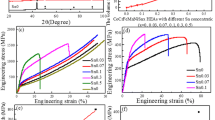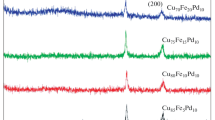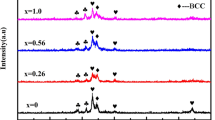Abstract
In this work, CoCrFexNi (x = 2, 3, 4) multi-principal element alloys were designed and synthesized by vacuum arc melting technique, and effects of Fe on microstructure and properties of CoCrFexNi alloys were investigated. The crystal phase and microstructure of these alloys were studied by X-ray diffraction and scanning electron microscopy, while mechanical properties were measured by Vickers hardness and compressive tests, respectively. The CoCrFexNi alloys presented a single face-centered cubic (FCC) structure with columnar crystal morphology, indicating that the Fe content doesn’t change the microstructure of CoCrFexNi alloys. However, the lattice parameters of FCC phases decreased with the addition of Fe element. It was found that all the alloys exhibited excellent ductility without fracture. In addition, the yield strength decreased, and the Vickers hardness varied from 124 HV for CoCrFe2Ni to 109 HV for CoCrFe4Ni.
Access provided by CONRICYT-eBooks. Download conference paper PDF
Similar content being viewed by others
Keywords
Introduction
Traditional alloys have been developing for thousands years, which usually have one principal element as the matrix. A new sort of alloys were researched, called multi-principal element alloys (MPEAs) or high entropy alloys (HEAs) [1, 2], which broke through the traditional alloy design concept. In traditional research of physical metallurgy and phase diagrams, intermetallic compounds which caused brittleness would be generated in multiple principal alloys. However, these MPEAs could simplify the microstructure due to the high entropy effect, and form solid solution such as face-centered cubic (FCC), body-centered cubic (BCC), or hexagonal close-packed (HCP) phases [3,4,5,6,7]. These alloys have good comprehensive properties, such as excellent corrosion resistance, wear resistance, thermal stability, etc. [8,9,10].
The typical CoCrFeNi MPEA has attracted extensive research attention because of its good ductility with a single FCC structure. Many CoCrFeNi-based MPEAs were investigated, such as CoCrFeNiTix alloys, CoCrFeMoxNi alloys, CoCrFeNbxNi alloys, and so on [11,12,13]. Above referred research is an efficient strengthening method through addition of larger-atomic size elements (Ti, Mo and Nb). However, the effects of inherent elements on CoCrFeNi alloy also have been rarely researched. In addition, the research has important significance for practical industrial applications. Therefore, effects of Fe element on the microstructure and properties of CoCrFexNi MPEAs were investigated in this study.
Experimental Procedures
The purity of master elements is higher than 99.9 wt%. Table 1 shows the nominal atomic percent of CoCrFexNi alloys. Alloys ingots were prepared by vacuum arc furnace with re-melting 4–5 times in a Ti-gettered high purity argon atmosphere with the pressure of 0.05 MPa and casted in a water-cooling copper crucible. Alloys ingots were the fastener-like shape with 30 mm in diameter and 10 mm in length. The crystal structures of alloys were analyzed by X-ray diffractometer (Empyrean) with CuKα radiation and a 2θ range from 20° to 100°. Microstructures of alloys were measured through Scanning Electron Microscope (SEM). Moreover, chemical compositions were determined by Energy dispersive spectrometry (EDS). And pure aqua regia was chose (HCL: HNO3 = 3:1) as the corrosive liquid to etch samples before observing microstructures. Universal testing machine tested compressive yield strength and ductility at a strain rate of 1 × 10−3 s−1. The experimental samples of compressive test were cut from ingots with a size of Φ5 × 10 mm. Every alloy prepared two samples to assure the accuracy of experimental results. The hardness was carried out by Vickers hardness tester under the load of 500 g applied for 15 s. Every ingot selected at least 5 points to take experiment and calculated the average value as the final results.
Results and Discussion
Crystal Structure. Table 2 shows the values of valence electron concentration (VEC), electro-negativity difference (χ), atomic radius difference (δ), and mixing enthalpy (ΔH). For CoCrFexNi alloys, the values of VEC > 8.0, δ < 4.72%, and 7.27 kJ mol−1 < ΔH < 4 kJ mol−1 indicate that these alloys should be possessed a simple FCC solid solution structure according to the reports in Refs. [4, 14]. Moreover, the value of χ is below 0.117 in CoCrFexNi alloys indicating inexistence of topological close-packed (TCP) phase [15]. The XRD patterns of CoCrFexNi alloys are presented in Fig. 1. The XRD peaks are indexed as a single FCC solid solution structure, which consisted with above theoretical prediction. Figure 1b is the magnifying pattern of (111)FCC peak. The peak of (111)FCC moves right gradually with the addition of Fe element. The lattice parameters of CoCrFeNi alloy [16] and CoCrFexNi are 3.5752, 3.5709, 3.5543, 3.5473 Å, respectively. The results are in agree with the change of (111)FCC peak in the Fig. 1b.
Microstructure. Figure 2 exhibits the low magnification SEM images of CoCrFexNi alloys. Because water-cooling copper crucible had rather fast cooling rate and ingots weren’t thick enough. Grains grew up from bottom to top figuring columnar crystal morphology with a size of 400–500 μm. From EDS mappings of CoCrFe2Ni alloy shown in Fig. 3, the elements distribution were uniform which was in accord with the microstructure identified the single phase structure. Other alloys were same as CoCrFe2Ni alloy, and the results weren’t put on the article to avoid repetition.
Mechanical Properties. The compressive engineering stress-strain curves of CoCrFexNi alloys are showed in Fig. 4. Three alloys exhibit excellent plastic with 50% compressive strain no fracture and the yield strength of 142, 132 and 103 MPa for CoCrFe2Ni, CoCrFe3Ni and CoCrFe4Ni, respectively. The excellent plastic of the alloys results from the single FCC phase which has multiple easy slip systems.
Figure 5 shows the relationship between Vickers hardness and the Fe content in CoCrFexNi alloys. The Vickers hardness decrease from 124 HV for CoCrFe2Ni to 109 HV for CoCrFe4Ni. With the increase of Fe content, both the Vickers hardness and yield strength decrease. This can be due to the decreased atomic radius difference (see Table 2) which leads to the lower lattice distortion.
Conclusions
In this study, effects of Fe element on microstructure and mechanical properties of CoCrFexNi MPEAs were investigated. And conclusions can be drawn as follows:
-
(1)
CoCrFexNi alloys present a single FCC structure and the lattice parameters decrease with the addition of Fe element. All the alloys exhibit large columnar crystal morphology with a size of 400–500 μm.
-
(2)
CoCrFexNi alloys possessed good ductility without fracture in compressive test. With Fe content increased, both the Vickers hardness and yield strength decrease which can be due to the decreased atomic radius difference.
References
J.W. Yeh, S.K. Chen, S.J. Lin, J.Y. Gan, T.S. Chin, T.T. Shun, C.H. Tsau, S.Y. Chang, Nanostructured high-entropy alloys with multiple principal elements: novel alloy design concepts and outcomes. Adv. Eng. Mater. 6, 299–303 (2004)
B. Cantor, I.T.H. Chang, P. Knight, A.J.B. Vincent, Microstructural development in equiatomic multicomponent alloys. Mater. Sci. Eng. A 375–377, 213–218 (2004)
J.W. Yeh, Y.L. Chen, S.J. Lin, S.K. Chen, High-entropy alloys—a new era of exploitation. Mater. Sci. Forum 560, 1–9 (2007)
Z. Wang, S. Guo, C.T. Liu, Phase selection in high-entropy alloys: from nonequilibrium to equilibrium. JOM 66, 1966–1972 (2014)
Z.S. Nong, J.C. Zhu, R.D. Zhao, Prediction of structure and elastic properties of AlCrFeNiTi system high entropy alloys. Intermetallics 86, 134–146 (2017)
W. Huo, H. Zhou, F. Fang, X. Hu, Z. Xie, J. Jiang, Strain-rate effect upon the tensile behavior of CoCrFeNi high-entropy alloys. Mater. Sci. Eng. A 689, 366–369 (2017)
H.W. Yao, J.W. Qiao, J.A. Hawk, H.F. Zhou, M.W. Chen, M.C. Gao, Mechanical properties of refractory high-entropy alloys: experiments and modeling. J. Alloy. Compd. 696, 1139–1150 (2017)
Y.Z. Shi, B. Yang, P.K. Liaw, Corrosion-resistant high-entropy alloys: a review. Metals. 7, 43 (2017)
C.Y. Hsu, T.S. Sheu, J.W. Yeh, S.K. Chen, Effect of iron content on wear behavior of AlCoCrFexMo0.5Ni high-entropy alloys. Wear 268, 653–659 (2010)
Z. Wu, H. Bei, F. Otto, G.M. Pharr, E.P. George, Recovery, recrystallization, grain growth and phase stability of a family of FCC-structured multi-principal element equiatomic solid solution alloys. Intermetallics 46, 131–140 (2014)
T.T. Shun, L.Y. Chang, M.H. Shiu, Microstructures and mechanical properties of multiprincipal component CoCrFeNiTix alloys. Mater. Sci. Eng. A 556, 170–174 (2012)
T.T. Shun, L.Y. Chang, M.H. Shiu, Microstructure and mechanical properties of multiprincipal component CoCrFeNiMox alloys. Mater. Charact. 70, 63–67 (2012)
H. Jiang, L. Jiang, D.X. Qiao, Y.P. Lu, T.M. Wang, Z.Q. Cao, T.J. Li, Effect of Niobium on microstructure and properties of the CoCrFeNbxNi high entropy alloys. J. Mater. Sci. Technol. (2016)
L. Jiang, Y.P. Lu, H. Jiang, T.M. Wang, B.N. Wei, Z.Q. Cao, T.J. Li, Formation rules of single phase solid solution in high entropy alloys. Mater. Sci. Technol. 1–5 (2016)
Y. Dong, Y.P. Lu, L. Jiang, T.M. Wang, T.J. Li, Effects of electro-negativity on the stability of topologically close-packed phase in high entropy alloys. Intermetallics 52, 105–109 (2014)
H. Jiang, K.M. Han, D.X. Qiao, Y.P. Lu, Z.Q. Cao, T.J. Li, Effects of Ta addition on the microstructures and mechanical properties of CoCrFeNi high entropy alloy. Mater. Chem. Phys. 1–6 (2017)
Acknowledgements
This work was supported by the National Natural Science Foundation of China (Nos. 51671044, 51471044 and 51525401), Dalian Support Plan for Innovation of High-level Talents (Top and Leading Talents, 2015R013), the Fundamental Research Funds for the Central Universities, and the National Key Research and Development Program of China (No. 2016YB0701203).
Author information
Authors and Affiliations
Corresponding author
Editor information
Editors and Affiliations
Rights and permissions
Copyright information
© 2018 Springer Nature Singapore Pte Ltd.
About this paper
Cite this paper
Han, L., Jiang, H., Qiao, D., Lu, Y., Wang, T. (2018). Effects of Iron on Microstructure and Properties of CoCrFexNi Multi-principal Element Alloys. In: Han, Y. (eds) Advanced Functional Materials. CMC 2017. Springer, Singapore. https://doi.org/10.1007/978-981-13-0110-0_28
Download citation
DOI: https://doi.org/10.1007/978-981-13-0110-0_28
Published:
Publisher Name: Springer, Singapore
Print ISBN: 978-981-13-0109-4
Online ISBN: 978-981-13-0110-0
eBook Packages: Chemistry and Materials ScienceChemistry and Material Science (R0)









